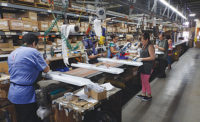Batteries are an environmentally friendly form of energy with fewer pollution and disposal issues than other green technologies. However, manufacturers are grappling with a variety of cost, quality, safety and weight issues. Battery engineers are tackling these challenges by improving economies of scale and developing efficient production processes.
Lithium-ion batteries, which currently lead the market for advanced batteries in applications ranging from consumer electronics to hybrid and electric vehicles, represent a significant step beyond traditional lead-acid technology.
However, the technology still falls short of market needs in terms of both technical performance and cost. These shortcomings and huge potential future demand for energy storage are driving engineers to develop a new generation of devices.
“The goal of this innovation is to find lower cost raw materials and increase lifecycle expectations,” says Kerry-Ann Adamson, research director at Navigant Research. “[That], in turn, will enable lower capital costs and lower total cost of ownership across all battery applications. Both electrified transportation and stationary storage [applications] demand lower price points to enable full electrification.
“Currently available advanced battery technologies for cleantech applications fall short of market needs,” claims Adamson. “While lithium-ion batteries have [gained widespread popularity], after nearly 20 years of commercialization efforts, the competitive field remains open.”
Growing Demand
Over the next decade, the advanced battery industry will experience huge growth. Emerging technologies from university and government laboratories around the world are currently addressing a wide variety of issues.
The United States is the epicenter of battery R&D efforts. In fact, the U.S. government boasts 39 battery and energy storage research programs managed by six federal agencies ranging from the Department of Defense to the Department of Energy.
“All told, these programs have invested roughly $1.3 billion from 2009 to 2012,” says Adamson. “Worldwide, the market for grid-scale advanced batteries will receive nearly $30 billion in investment between now [and the end of this decade].” At the same time, global demand for advanced batteries is expected to triple from $10 billion today to more than $30 billion by 2020.
Despite huge potential, production volumes remain relatively small. At the same time, costs are still high.
According to the National Renewable Energy Laboratory (NREL), the cost of the materials in a large-format lithium-ion cell (which NREL calculates as about 52 percent of total cell cost) equals the cost of an entire consumer electronics battery cell (about $200 per kilowatt hour), even though both cells use similar materials.
“With developments in next-generation batteries and the initial focus being on electric vehicles, the cost of batteries is [quite] high,” says Vishal Sapru, industry manager at Frost & Sullivan Inc. “The adoption of electric vehicles has been slow and that has resulted in high costs for manufacturers of these batteries.
“To offset the cost, manufacturers are looking at other [industries] that can use these batteries such as defense, telecommunications and electric utilities,” adds Sapru. “The same battery with slight modifications can be used in these applications.”
One of the fastest growing segments of the lithium-ion market is thin, flat-pouch cells in laminated foil packages. They provide better power and capacity vs. traditional cylindrical cells. A flat-cell design also sheds waste heat better, which contributes to increased safety and longer battery life. And, the thinner profile enables ultra-thin electronics.
“Next-generation [devices] are able to reduce the overall weight of the battery and provide increased life cycle, high energy density and improved charge efficiency, while also operating in extreme conditions,” explains Sapru.
“The key issue that still needs to be addressed is cost,” Sapru points out. “The initial cost of such batteries is likely to [remain] high until demand increases to make them cost-competitive.”
Several types of advanced battery technologies are being developed today, such as lithium-air, lithium-water and lithium-sulfur. Engineers at IBM Corp., Toyota Motor Corp. and other large manufacturers have been focusing on lithium-air batteries. They feature a higher energy density than lithium-ion batteries, due to their lighter cathodes and the fact that their primary fuel is oxygen. Lithium-air batteries require less material and allow engineers to use lighter packaging than lithium-ion batteries.
“Lithium-air batteries are very interesting, because they offer one of the highest theoretical energy densities since one of the electrodes is air,” says Tim Feaver, CEO of Porous Power Technologies LLC, a company that makes electrode separators used in large lithium-ion batteries. “But, there is much research to be done to make these cells practical.
Another emerging technology that holds promise is the solid-state battery. Instead of using a liquid electrolyte, it uses a solid electrolyte that allows engineers to create a more compact and more stable battery that packs a high voltage into a smaller space.
“Solid-state batteries show promise for credit cards, asset tracking and similar mobile applications where a lot of energy or power is not required,” says Feaver. “They are less promising for the larger cells used in most consumer electronics, and even less so for electric bikes, autos, tools and similar applications.”
No matter what happens in the near-future, most experts don’t see lithium-ion batteries going the way of incandescent light bulbs any time soon.
“There is a high level of interest industry-wide in improving the capacity of lithium-ion cells through high-capacity anodes and high-voltage chemistries,” adds Feaver. “Hybrid ultracapacitors that have the long cycle life and high power of capacitors, but energy densities approaching those of lithium-ion cells, are also generating a lot of interest.”
“There is no denying chemistry’s role in future batteries is a large one, even though for the most part, the focus will remain on lithium-based chemistries,” adds Bob Sweeney, vice president of operations at Palladium Energy Inc., a leading manufacturer of lithium-ion battery packs.
“The trend will be toward cathode and anode development near term to increase energy density and lower cost in near future energy storage systems,” explains Sweeney. “Electronics management systems will also increase in size and complexity, [because] there will be a trend to rethink the battery by focusing on optimization and safety with respect to the host system.”
Assembly Challenges
Mass-production is a nagging issue for next-generation battery manufacturers. In fact, last month, the National Alliance for Advanced Technology Batteries (NAATBatt) sponsored a workshop on how to reduce the cost of manufacturing lithium-ion batteries in the United States. According to Jim Greenberger, NAATBatt’s executive director, “much of the low-hanging fruit for battery cost reduction lies in developing better, faster and more efficient ways to make batteries.”
“Today, production of battery cells is still a one-at-a-time process,” notes Feaver. “To reduce costs, battery manufacturers are pursuing a variety of avenues.
“The best way to make [batteries] cheaper is to make them faster and improve production yields,” claims Feaver. “Manufacturers are experimenting with automating various aspects of the assembly process and moving toward more automated cell assembly lines and away from hand-assembled products, even in China. Increased labor costs are creating even more incentive to automate cell manufacturing.”
Traditionally, flat-stacked batteries have been difficult and expensive to produce. “An electrode is like a piece of foil, but thinner than what you use in the kitchen,” explains Feaver. “The separator is even thinner yet and can behave like the kitchen plastic wrap you use to cover bowls, sticking to itself or wrinkling. In a cell, the electrodes and separator must be aligned very precisely, which is exceedingly difficult and time-consuming with these thin materials.”
The machines currently used to create flat-stacked batteries are robotic pick-and-stack devices. They use optical alignment technology to precisely place each individual component onto a stack. No matter how big or small the cell is, the stacker adds one layer at a time, at an average rate just under one second per layer.
A typical electric vehicle battery may have 200 layers or more (50 electrode pairs and 100 layers of separator). Building just one at this rate takes more than 3 minutes. In comparison, a similar sized traditional wound cell typically takes just 30 seconds or less to make.
“This is why manufacturers have stayed with the winding process, despite its drawbacks,” Feaver points out. “Until now, there has not been a quick, cost-effective way to manufacture the highest-performance cell designs.”
Porous Power recently developed a high-throughput cell production system called the Matrix Assembly System. It allows simultaneous stacking or winding of dozens or hundreds of cell assemblies, rather than using current one-at-a-time production techniques.
“The biggest barrier to widespread adoption remains performance vs. capacity and price,” says Palladium Energy’s Sweeney. “It is just not volume production that is required to bring the costs down, but technology improvements and design efficiency.
“The biggest trend in the industry is toward increasing battery testing capabilities and increasing host system awareness in order to decrease development time,” adds Sweeney. “It allows engineers to work through issues before they hit the production floor. Then, one needs to address these elements in the production chain—first by improving the technology; second by bringing down production costs with manufacturing technology; and third through standardization.”
Palladium Energy recently implemented a new program involving robotics and automation. “This worked great for us, since the program was one product with high volumes,” Sweeney points out. “Most of the automation was centered around mechanical, dimensional and electrical functional testing. We want to take this experience and see if we can apply it economically to the larger part of our business that is lower volume with much higher mix.”
Palladium Energy specializes in engineered custom batteries for a variety of industries, ranging from medical to defense, rather than manufacturing large quantity AA alkaline batteries for consumer consumption.
“We have reasonable volumes in our consumer-oriented products, but generally we are faced with the challenge of lower volumes and higher mix,” explains Sweeney. “Most of our processes are manual and semiautomatic. So, for us, we think more about economies of scope.
“Our focus in this manufacturing challenge is around deployment of lean production tools and flexible processes,” adds Sweeney. “We are deploying classic concepts of quick-change, small-batch pull systems and mixed-model manufacturing in production cells focused around product families.”








